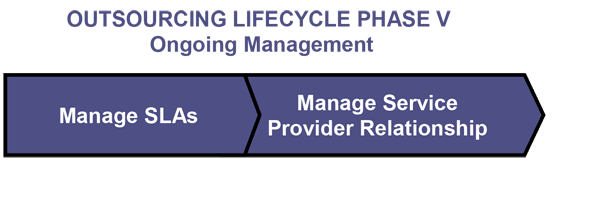 By Jeff Richards
By Jeff Richards
Managing Partner
The decision to outsource a business process or an IT function is a significant one, and to ensure you achieve the desired outcomes care must be taken at each stage of the outsourcing lifecycle. In previous posts we introduced the outsourcing lifecycle and talked about each of the first three phases of this cycle: assessing outsourcing opportunities, selecting an outsourcing service provider and developing and negotiating an outsourcing contract.
In this final post in the 5-part series we will cover phases IV and V of the outsourcing lifecycle. In these phases the contract is implemented, and the relationship and Service Level Agreements (SLAs) are managed on an on-going basis.

While this phase only has two stages, it is the place where all of your and the service provider’s efforts either come to fruition or go off the track. If the latter occurs then for months to come – if not for the life of the contract – both parties will spend inordinate amounts of time trying to regain their credibility and repair the relationship. This risk can be mitigated by proper planning, process design and skills transfer.
Plan the Service Transition
Just like contract negotiation, service transition is another area where there is no replacement for experience. This factor should be weighted heavily in your evaluation and reference checks of service providers. Have they done this before, in your industry, with these specific processes or technologies?
Execute the Service Transition
Do not be impatient with this stage! It will usually take significant time to prepare for the service cutover. Have contingency plans and additional resources standing by to deal with the difficulties that will unfailingly appear with the inception of services.

Manage SLAs and the Service Provider Relationship
Just because you’ve outsourced a process or function doesn’t relieve you of the responsibility of managing that process and delivering results to your company. Ongoing proactive management of performance to SLAs and the overall relationship between you and your service provider is the only thing standing between you and service degradations, dissatisfaction, executive escalations, unplanned change orders and early renegotiation or termination of the contract.
Depending on the scope and scale of what you’ve outsourced you’ll need to assign full-time resources or a team to manage your contribution and the service provider’s performance. If this relationship is treated as a partnership, and the issues that will invariably arise are quickly addressed, it is likely your contract will run its term and allow you to renew or begin this process again.
Conclusion
As always, it is our advice that a methodology is a guide to thinking, not a replacement for thinking. This series is intended to be an overview of the journey you need to navigate. In the interest of brevity we’ve left out several branches and tributaries to the route. For more information on the outsourcing lifecycle – or for help negotiating it – please contact us.
About Jeff Richards
As an inspirational leader with the ability to develop the “big picture” strategy then drive it down to executable tactics for implementation, Jeff leads our Professional Services team. Clients benefit from Jeff’s 25+ years of experience developing and implementing transformative business strategies.
Jeff’s experience spans both industry (including Materials, Operations and IT Management) and consulting. He developed a unique global perspective during his tenure in significant P&L management-level positions in both Asia and Europe.
About CIO Professional Services
CIO Professional Services LLC is a top-rated IT (Information Technology) consulting firm, based in the San Francisco Bay Area, specializing in strategic IT consulting and business / IT alignment. Companies come to us seeking assistance with their information technology strategy as well as to source interim CIO / CTO employees or fractional CIO / CTOs.


